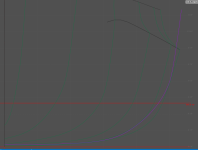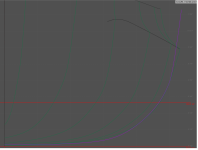No Title
And I thought that I had the design finished!
I had actually started lofting lines to form material, and realized (actually, my dad pointed it out - always good to have another set of eyes!) that the chines seemed a little sharper than I intended. I pulled down one of my old forms, and he was right. Attaching here a drawn line, compared to the last design I had posted, and to what I am now going to build.
New delft file up, this is what I am going to build! Probably cut forms today, and yes, there will be a build thread.
https://drive.google.com/open?id=0B8dhNVBeB9VTUjZBUWV5X2QxRW8&authuser=0
In the images, the purple line is center form for my last canoe. Current design I am designating KnuckledCanoe3d "The Experiment"
static stability looks to be right about the middle of the designs I've been goofing with, 1.47 ft metacentric height.
4" WL right on 400#
2.4" WL for 200#, so solo and trimmed flat, I should just have the entire hull to the stems wet.
And I thought that I had the design finished!
I had actually started lofting lines to form material, and realized (actually, my dad pointed it out - always good to have another set of eyes!) that the chines seemed a little sharper than I intended. I pulled down one of my old forms, and he was right. Attaching here a drawn line, compared to the last design I had posted, and to what I am now going to build.
New delft file up, this is what I am going to build! Probably cut forms today, and yes, there will be a build thread.
https://drive.google.com/open?id=0B8dhNVBeB9VTUjZBUWV5X2QxRW8&authuser=0
In the images, the purple line is center form for my last canoe. Current design I am designating KnuckledCanoe3d "The Experiment"
static stability looks to be right about the middle of the designs I've been goofing with, 1.47 ft metacentric height.
4" WL right on 400#
2.4" WL for 200#, so solo and trimmed flat, I should just have the entire hull to the stems wet.


